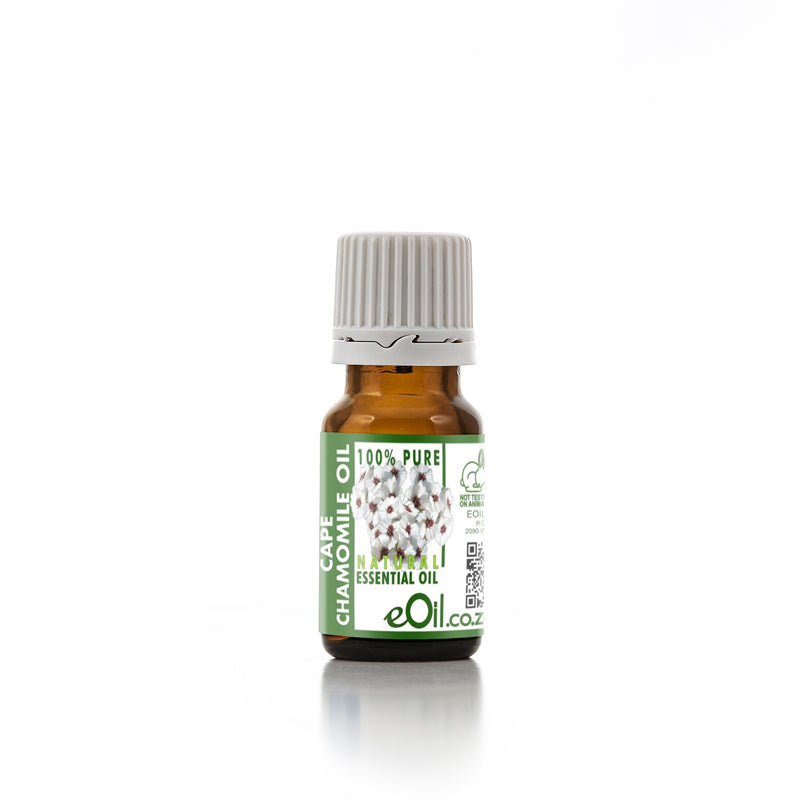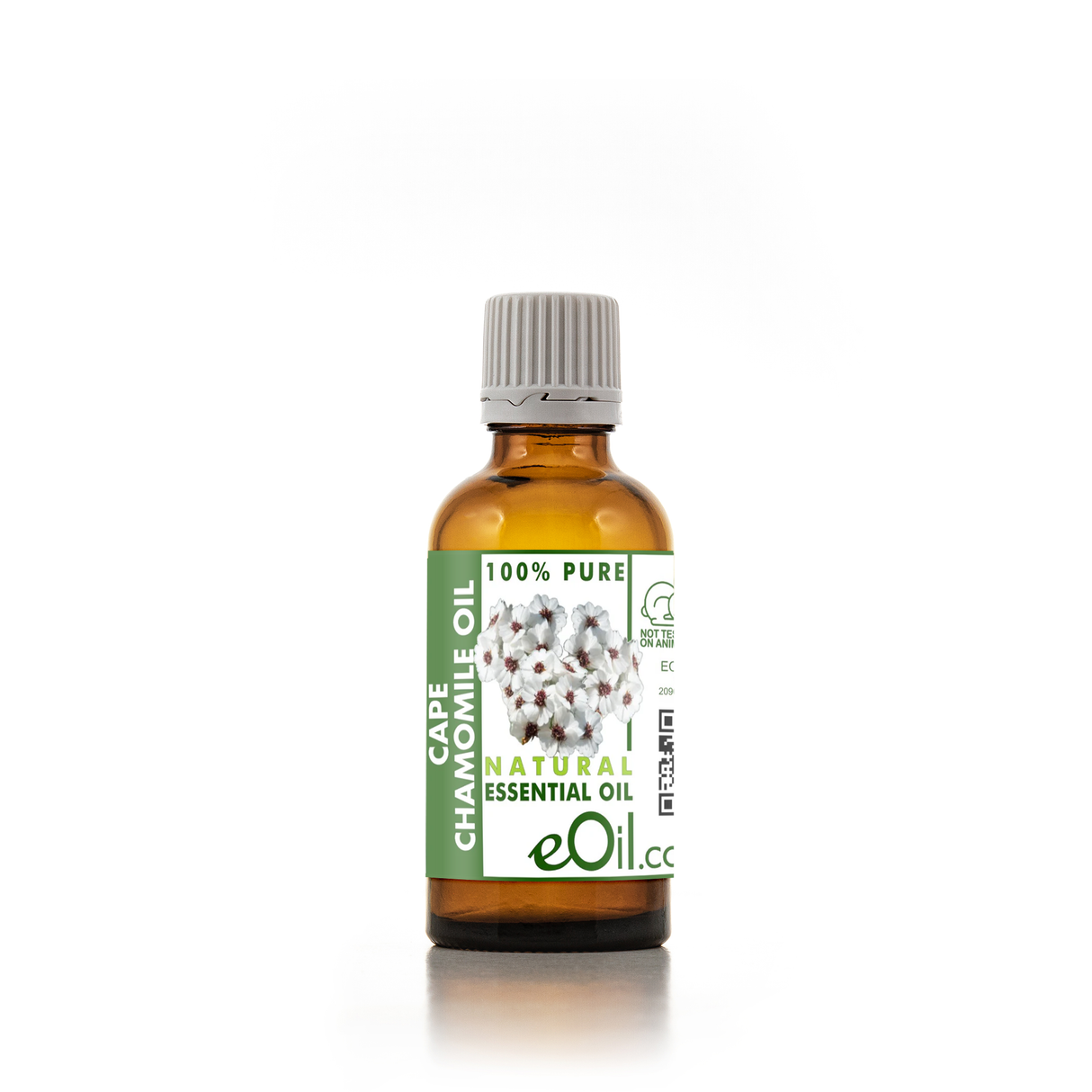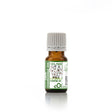Cape Chamomile Essential Oil
Cape Chamomile Essential Oil - 5 ML is backordered and will ship as soon as it is back in stock.
Description
Description
Cape Chamomile Essential Oil ( Eriocephalus punctulatus ) is a rare South African oil, renowned for its calming, sweet floral aroma and vivid blue color.
Traditionally valued for promoting relaxation and emotional balance, it's highly prized in aromatherapy and skincare.
Naturally steam-distilled and 100% pure
IDENTIFICATION
INCI Name : Eriocephalus punctulatus (Cape Chamomile) Flower oil
CAS Number :68916-49-4
EXTRACTION METHOD: Steam distilled essential oil from commercial plantations.
PARTS USED: Flowers, Leaves and Twigs.
ORIGIN: South Africa. Eriocephalus plants are found growing wild on the mountain slopes of the Cape region and in the Northern Cape karoo. Our essential oil comes from sustainable commercial plantations and exploitations, to protect the plant in its wild fynbos natural habitat.
COMMON NAMES: Cape Camomile, Kapok bush, snowbush .
APPEARANCE: Clear, pale to dark blue, blue-green liquid.
ODOUR NOTE: Middle to top note. Floral-fruity (pineapple, apple, pear), honeyed, sweet, warm, herbaceous and earthy, softly spicy aroma
QUALITY: 100 % pure and natural, whole essential oil.
STORAGE CONDITION: Store in a cool dark place.
Essential oil molecular constituent/chemotype:
The Cape Chamomile essential oil has a complex composition, with more than 50% of rare aromatic aliphatic esters (mainly ISOAMYL ISOBUTYRATE and ISOBUTYL BUTYRATE), calming linalyl acetate and nourishing azulene compounds (Plus many other antimicrobial components like paracymene, terpinene, α-pinene, 1,8-cineole or camphor)
INFOGRAPHIC CHAMOMILE ROMAN VS GERMAN VS CAPE VS BLUE TANSY
Here's a comparison table of the four types of chamomile essential oils:
| Characteristic | Roman Chamomile | German Chamomile | Cape Chamomile | Blue Tansy |
|---|---|---|---|---|
| Scientific Name | Anthemis nobilis or Chamaemelum nobile | Matricaria chamomilla or Chamomilla recutita | Eriocephalus punctulatus | Tanacetum annuum |
| Plant Type | Perennial | Annual | Perennial | Annual |
| Color | Pale yellow to light blue | Deep blue | Light blue | Deep blue |
| Aroma | Sweet, fruity, warm, herbaceous | Strong, sweet, herbaceous, hay-like | Sweet, fruity, apple-like | Sweet, herbaceous |
| Main Chemical Components | High in esters | High in chamazulene, bisabolol | High in esters, some azulene | High in chamazulene, camphor |
| Key Properties | Antispasmodic, calming, soothing | Anti-inflammatory, calming, soothing | Stress-relieving, anti-inflammatory | Anti-inflammatory, antihistamine |
| Main Uses | Skin care, digestive issues, menstrual cramps, stress relief | Inflammation, allergic reactions, skin irritations | Stress relief, skin care, pain relief | Allergies, inflammation, muscle soreness |
| Unique Features | Known as "noble" chamomile, best for spasmolytic action | Strongest anti-inflammatory properties | Rare oil, good for times of change (e.g., menopause) | Contains camphor, not a true chamomile |
| Safety Considerations | Avoid in early pregnancy | Generally safe | Limited research available | Avoid extended use due to camphor content |
Key differences:
- Roman Chamomile is best known for its antispasmodic properties and is often preferred for digestive issues and menstrual cramps.
- German Chamomile has the strongest anti-inflammatory properties due to its high chamazulene content, making it ideal for skin irritations and allergic reactions.
- Cape Chamomile is less common but highly valued for stress relief and emotional balance, particularly during life transitions.
- Blue Tansy, while not a true chamomile, is often grouped with them due to its similar properties. It's particularly useful for allergies but should be used cautiously due to its camphor content.
When choosing between these oils, consider the specific therapeutic properties needed and any safety considerations, especially for long-term use or with sensitive individuals.

RECIPES USING CAPE CHAMOMILE
REPORTED BENEFITS & PROPERTIES
Mainly:
- Powerful antispasmodic +++.
- Anti-inflammatory +++.
- Broad and varied antimicrobial, anti-fungal: +++
- Analgesic ++.
- Sedative++
- Diuretic and Diaphoretic (induce perspiration): ++.
INFOS AND INTERESTING FACTS
Cape Chamomile is an aromatic fynbos plant found from the Northern Cape Karoo and all along the eastern and west coast belt of South Africa. Its common name, “chamomile”, comes from its flower’s appearance. Its steam distilled essential oil chemical composition, however, is very different from that of the German, Roman and other Chamomiles. The beautiful deep blue colour of the Cape chamomile essential oil comes from the presence of the calming azulene molecules in the distilled flowers and is very effective in calming and relaxation blends for wellbeing. This rare, very fragrant, fruity, floral, lingering essential oil is also recommended in soothing and calming skin care formulations and to create superior, high-end, natural perfumes.
TRADITIONALLY USED
In wellbeing massages to soothe gastro-intestinal/ stomach related cramps: +++
In mental and body relaxation +++
- For Mental and Emotional wellbeing: as a support in programs to overcome depression.
- Reported to be particularly helpful for the over-stimulated mind, and overactive emotions. To help with general irritability
- In support of all stress related manifestations: anxiety, fear, exhaustion, depression and other.
- To help promote deep and restful sleep and generally to improve the quality of sleep and sleep patterns. ++ Cape chamomile essential oil has reported relaxing and sedative properties.
- In soothing blends for neuralgia or inflammatory neuropathy-related manifestations (numbness, tingling, burning) ++.
- In antispasmodic balms or ointments applied topically to the skin for digestive cramps.
- In antispasmodic massages on the skin for colitis, cystitis, period pains cramps.
- In relaxing and deep tissue massage, to help eliminate muscle tensions, pains and in headaches.
- For Its anti-inflammatory properties, in massages to help reduce swellings, oedemas caused by sprains and strains, rheumatism.
- As a diuretic agent in detox massages and creams
- In wellbeing massages to alleviate the symptoms of respiratory related discomforts related to colds and seasonal flu
In body care, hygiene & natural beauty:
Anti-microbial, Antifungal, Anti-inflammatory and deeply soothing, it is an excellent essential oil, to include into hygiene creams, lotions, balms and oils, into homemade cosmetics or high-end natural beauty products.
- For Body care: +++
- For Face care: +++
- To help with skin inflammations eruptions: boils, abscesses, allergies, acne…
- In balms and creams for skin rashes, eczema and dermatitis
- In specialty antimicrobial creams and lotions for minor cuts, grazes and wounds, insect bites, sunburn, etc.
- General minor inflamed skin problems especially for sensitive skins.
- In creams and balms for nappy rash,
- In oils and creams to massage the areas around ear and tooth ache, teething pains, toothache, swollen gums, sore throat.
- For irritated Scalp, Haircare: +++
In Baths and Hygiene products: +++
Added to baths salts or milks, to promotes muscle and body relaxation
In hygiene seat baths to soothe urticaria, vaginitis.
In Compresses: ++
- In localized anti-inflammatory compresses to help reduce swellings caused by sprains and strains.
In Ultrasonic & Steam diffusion, in inhalation and atmospheric sprays: +++
In support of respiratory related conditions, colds and flu
- In support of all stress related manifestations: anxiety, fear, exhaustion, depression and other. To help maintain mental and emotional balance
- To bring calm and balancing support at emotionally difficult, transitional times of life as in adolescence and menopause.
In other application
- Natural Perfumery: +++
INSTRUCTIONS OF USE
Massages & body care
- Body massages use 1 to 6 drops essential oil for 10 ml carrier oil (0.5 to 2 % concentration) +++
- Face care use 1 to 3 drops essential oil for 10 ml carrier or base (0.5 to 1 % concentration) +++
- Body & Hair care use 2 to 6 drops essential oil for 10 ml carrier or base (1 to 2 % concentration) +++
- Baths +++: For a totally relaxing and comforting bath experience: First mix 10 to 15 drops of cape chamomile essential oil with 20 ml vegetable glycerine or 1 cup of Epsom salts. Add to your warm bath water (mix with lavender)
Diffusion
A few drops added to a diffuser, to calm and soothe the senses.
- Ultrasonic Diffusers for air purification, use 10 min 3 times a day. +++
For more detailed information, please go check this LINK TO Instructions of use essential oils page
DO NOT USE UNDILUTED and SEEK MEDICAL AND SPECIALIST ADVISE WHEN IN DOUBT.
SEE OUR PAGE ON PRECAUTION - HOW TO USE ESSENTIAL OILS SAFELY
BLENDS WELL WITH
- For calm and stress related, in support of depression with Ylang-Ylang, petit grain, Bergamot, Neroli, Litsea cubeba, Frankincense, Rose, Rosemary.
- For better sleep patterns: with Lavender, Roman chamomile, Marjoram,
- For mood boosting: Lemon, Mandarin, Sweet Orange, grapefruit. Geranium, Ginger, Palmarosa, Sandalwood, Vetiver, Benzoin
- Period pains, Spasm massages: with Tarragon, Cypress, Marjoram, Clary Sage in St John’s wort, Calendula or Arnica.
- For face: Clary sage, Sandalwood, Helichrysum, Myrrh essential oils, Rosehip oil, Calendula oil.
- In perfumery to strengthen green or herbal notes: Bergamot, Clary Sage, Cilantro, Rose Geranium, Rosewood, Rose, Ylang-Ylang, Jasmine, neroli; with Patchouli, frankincense, Vetiver, Sandalwood.
- To enhance fruity aromas (Litsea cubeba, Grapefruit and other citrus),
- With fruity or floral blends with spicy notes: Bergamot and Cloves; Rose, Ylang-Ylang and Jasmine; Sandalwood.
- To create luxurious perfumes with Rose, Rose geranium, Vanilla and Coriander or with Jasmine, Sandalwood, Cedarwood and Vanilla…
CAUTION
Do not use during pregnancy
For more detailed information, please go check this LINK TO Instructions of use essential oils page
DO NOT USE UNDILUTED and SEEK MEDICAL AND SPECIALIST ADVISE WHEN IN DOUBT.
SEE OUR PAGE ON PRECAUTION - HOW TO USE ESSENTIAL OILS SAFELY

Cape Chamomile Essential Oil - 5 ML is backordered and will ship as soon as it is back in stock.




